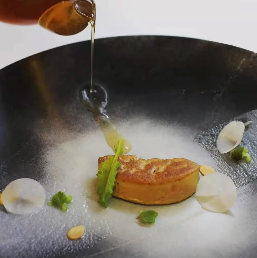Each country has its own characteristic diet, but also reflects the unique national culture, France as the world’s recognized food kingdom, its characteristic cuisine – French food, for many people, are both familiar and mysterious.The familiarity lies in hearing about it, the mystery lies in how few people really know about it. In fact, French food is unique. French food culture, as an important window to understand France, reflects the elegance of French people everywhere, which is worth people to savor.
Cuisine culture: artistry and richness coexist.
French food is superior to other Western food in terms of its attention to ingredients, heat, collocation of dishes, freshness of selected materials, diversified dishes from different regions and delicacy, rationality and artistry of cuisine.
For starters, Pan-fried Luger Foie Gras.
Spices commonly used include: thyme, rosemary, bay, parsley, tarragon, nutmeg, saffron, lilac, and a hundred kinds of sauces, both subtle differences in taste and color.
There are no more than a dozen different types of dishes, compared to the vast array of ingredients. There is a loaf of bread before the food is served, and then the waiter removes the plate for a second course.
The second course is soups, delicious French soups, thick broth, light vegetable soup and delicious seafood soup.
Soup “Pumpkin Soup”.
The third course is the main course of a meal. The main course is various kinds of “chops”, chicken chops, fish chops, steak, pork chops. The so-called steak is pure meat with bones and spines removed, and then poured with a special sauce. It tastes delicious and is convenient to eat.
Main course “M7 Wagyu Beef Eye Steak”.
This is followed by dessert, which can be fruit, coffee, cake or ice cream.
Dessert “Creme Brulee”.
French specialties include “bouillabeux de Provence” from Marseille, foie gras, stewed beef in red Burgundy, pheasant in red wine, baked escargot and so on.
Table culture: Romantic scenes compatible with aristocratic temperament.
There’s more to the romance and nobility of the French than the powerful designs on the catwalk. The French not only pay attention to the dining etiquette, but also the special pursuit of the mood of dining, they even give philosophical significance to the food, the table dining as a kind of elegant pleasure and enjoyment.
The almost prosaic lifestyle of a family sitting around a tree-lined courtyard enjoying the most intimate food is also a way to learn about a culture. Table culture is not only the daily etiquette of French people, but also the scene of many events, such as quarrel, comfort, communication and encouragement, which can not help but make people feel that this is the life and it is around.
French dinner, in addition to the rich menu, there are all kinds of exquisite tableware, they are placed in their own position, presumably the first time to see so many knives, forks, cups and saucers you will be confused, want a “instructions”, but also need to savor.
Proper French table setting.
The easiest way to do this is to place your plate in the center of your face, your napkin inside the plate, your fork on the left, and your knife and spoon on the right. Right in front of the plate, from left to right, are water glasses, red wine glasses and white wine glasses.
A world-class dietitian once said, “The whole personality of a nation can be judged by the atmosphere at the table.” Therefore, French people do not stop at the stage of filling the stomach for food, it is more an attitude to enjoy life.
It takes four to five hours to enjoy a formal French meal, from appetizers, seafood, meat, cheese to dessert. Although the process is complicated, the important thing is not how much food is eaten, but the atmosphere of the restaurant is fully enjoyed in the taste of the meal, appreciate the combination of cutlery and food.
Wine Culture: the carrier of elegant history and civilization.
Wine is a necessary item on the table of French people every day. The wine culture of France grows and develops along with the history and civilization of France. The wine culture has penetrated into all aspects of French people’s religion, politics, culture, art and life. It has become an integral part of French food culture.
France as the world’s main wine production country, the country has 10 wine production regions, a wide variety of wine, Bordeaux, Burgundy wine production, Champagne region in the world’s most famous champagne.
On the table, French people also pay great attention to the collocation of wine and dishes, such as drinking light aperitif before meals, eating salads, soups and seafood, drinking white wine or rose wine; Red wine with meat and a dash of brandy or sweet wine after dinner. Champagne is used for celebrations.
Wine for diners.
Cheese culture: A year of sweet food.
General de Gaulle once lamented: “How can anyone govern a country with 246 kinds of cheese?” In fact, at present, there are up to 487 kinds of cheese in France, that is to say, the French people can eat different kinds of cheese every day 365 days a year, so on the French table, cheese is also a must for every meal.
There are roughly eight types of French cheese: fresh cheese, crusted cheese, washed cheese, blue cheese, goat cheese, hard unripe cheese, hard ripe cheese, and melted cheese. There is an art to eating cheese, and the right way to mix it can help you feel its rich flavor.
Generally speaking, mild cheese, must be accompanied by soft wine; Salty cheese should be paired with strong red wine. For fresh cheese, choose crispy French bread, while for rich, aged cheese, choose whole-grain bread with a strong flavor. The formation of French cuisine and its unique food culture are the products of many factors.
